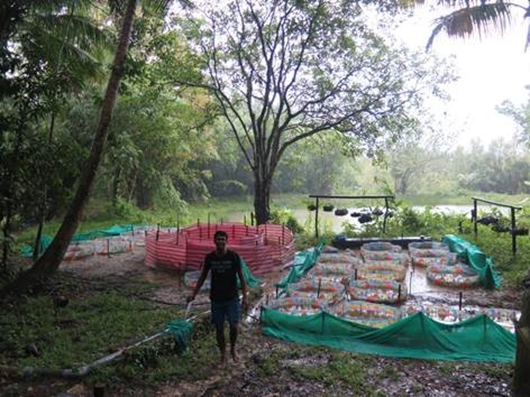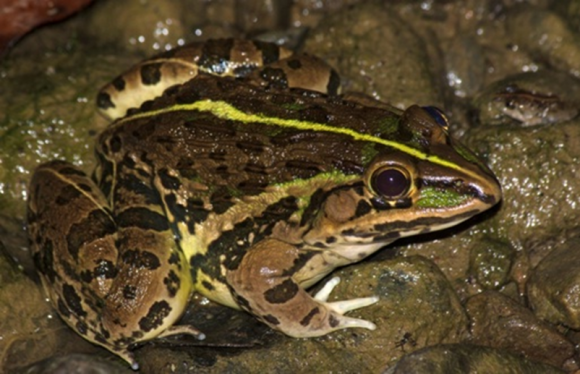10 May 2019 | By Nitya Prakash Mohanty
Tadpoles of endemic frog species on the Andaman archipelago (1200 km east of the Indian mainland) do not survive high levels of predation by invasive Indian bullfrogs larvae, finds a new study by C·I·B researchers Nitya Prakash Mohanty (Post-doctoral fellow) and John Measey (Core Team Member).
The Indian bullfrog (Hoplobatrachus tigerinus) has been recently introduced to the Andaman archipelago, a global biodiversity hotspot, where it has spread rapidly. Adults of the invasive bullfrog have already been shown to prey upon a range of endemic vertebrates and can potentially outcompete native frogs. In this study, the researchers aimed to understand the effect of carnivorous bullfrog tadpoles on co-occurring native frog tadpoles. For this, they designed a mesocosm experiment with tadpoles of the invasive bullfrog and of two endemic frogs (the Chakrapani’s narrow-mouthed frog and the Andaman tree frog). Both competitive and predation effects of bullfrog tadpoles on the native tadpoles’ survival, growth, and time to metamorphosis were examined.

The experiments showed that rapid predation by bullfrog tadpoles left no surviving native frog tadpoles. Surprisingly, most native tadpoles were consumed within a week. When left to themselves, the native tadpoles did much better, with three in every four making it to metamorphosis. On the other hand, bullfrog populations growing with native frog tadpoles had higher survival relative to populations with just bullfrog tadpoles. The experiment reveals that in natural conditions, endemic frogs – many of which breed in similar habitats as invasive bullfrogs – are highly vulnerable as tadpoles. The findings of the study also substantiate the ecological and economic concern generated by the bullfrog invasion and underline an urgent need for management action.
“The study provides a ‘proof of concept’ that bullfrog tadpoles can impact native frog populations through severe carnivory”, says Nitya Prakash Mohanty, “We have documented rapid predation on two endemic frog tadpoles leading to no survival”. He adds “Given the bullfrog spawns a large number of eggs in the same breeding sites as the native frogs, carnivorous bullfrog tadpoles could drastically bring down populations of native frogs.”
Read the paper at:
Mohanty NP, Measey J. (in press). No survival of native larval frogs in the presence of invasive Indian bullfrog Hoplobatrachus tigerinus tadpoles. Biological Invasions DOI: 10.1007/s10530-019-01985-z
Nitya’s previous study:
Mohanty NP, Measey, J. (2019). Reconstructing biological invasions using public surveys: a new approach to retrospectively assess spatio-temporal changes in invasive spread. Biological Invasions DOI: 10.1007/s10530-018-1839-4
Mohanty NP, Measey J. (2018) What’s for dinner? Diet and potential trophic impact of an invasive anuran Hoplobatrachus tigerinus on the Andaman archipelago. PeerJ6:e5698 https://doi.org/10.7717/peerj.5698
For more information, contact Nitya at nitya.mohanty@gmail.com
Media links



